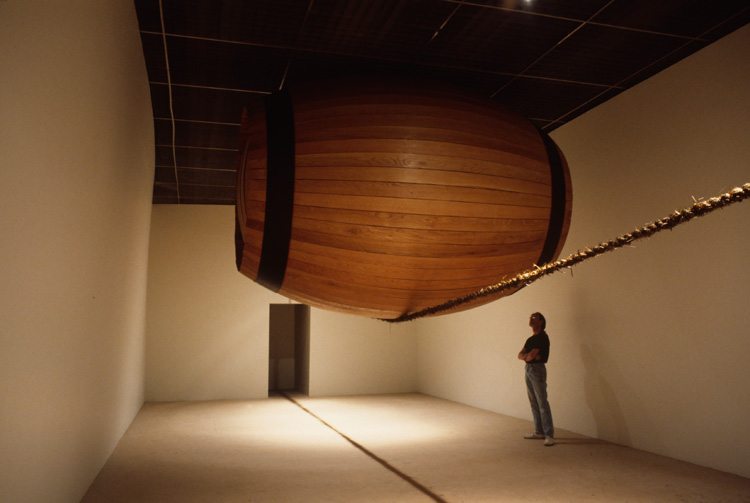
1994
white oak, mixed tall-grass prairie plants, steel, industrial patina, sheetrock, paint
12 x 20 x 50 feet
In Spirit, an enormous swollen barrel is balanced on a tightrope of grass and grain in a room where the walls bow inward under a surreal strain. Characterizing an uneasy relationship between industry, agricultural America, and nature throughout the 19th and 20th century, Spirit constructs a portrait of a landscape on the line. The thick rope, braided with native grasses indigenous to the American Prairie, represents an inter-connective ecology. Spanning the room in this installation, utilizing plants like Big Bluestem Grass, Indian Grass, and Switchgrass, this “tightrope of biodiversity” is a material portrait of a once extensive natural system now reduced to a threadlike trace straining to exist under a massive cask. The original industrial measure of production, whether of food or fuel, is the barrel or ton.
The ton (OE, tunne, large cask) in this work is an uncomfortable stand-in for a century of production on top of a fragile representation of the historic prairie. Spirit concentrates its critique on a culture intoxicated with production and its commodities, continuing to maintain its “act”. This act has an illusion of abundance, balance and control with a natural environment, while the ecology that signals its catastrophic fall is to be considered an impediment to its progress, competitiveness and bravado. This work takes a specific American landscape as its metaphor, the Tall Grass Prairie. Now largely extinct, this prairie is part of a powerful history and mythology: the American pioneering spirit. The uncomfortable side of that spirit is placed in the barrel form, a monstrosity distended, full of itself, stuck in the middle, unable to continue its roll over a line of dying green.
The funambulist or tightrope artist calls the inner core of the rope the “soul.” The soul of the American landscape is the variety of life that exists upon the myriad forms of rock and soil. A society maintaining a mind of endless consumption is a burden that the soul cannot bear. The political attitude at the end of the 21st century placed the preservation of the remaining natural ecology in an uneven competition with the frantic production of capital in the midst of a greatly degraded environment.














